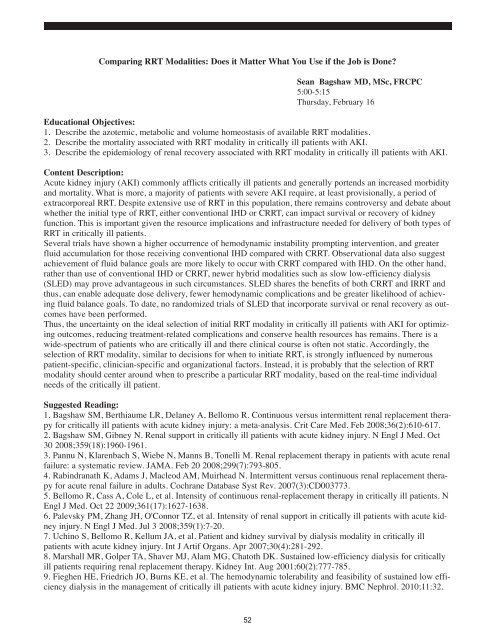ABSTRACTS from 16th International COnference on ... - CRRT Online
ABSTRACTS from 16th International COnference on ... - CRRT Online
ABSTRACTS from 16th International COnference on ... - CRRT Online
Create successful ePaper yourself
Turn your PDF publications into a flip-book with our unique Google optimized e-Paper software.
Comparing RRT Modalities: Does it Matter What You Use if the Job is D<strong>on</strong>e?<br />
Sean Bagshaw MD, MSc, FRCPC<br />
5:00-5:15<br />
Thursday, February 16<br />
Educati<strong>on</strong>al Objectives:<br />
1. Describe the azotemic, metabolic and volume homeostasis of available RRT modalities.<br />
2. Describe the mortality associated with RRT modality in critically ill patients with AKI.<br />
3. Describe the epidemiology of renal recovery associated with RRT modality in critically ill patients with AKI.<br />
C<strong>on</strong>tent Descripti<strong>on</strong>:<br />
Acute kidney injury (AKI) comm<strong>on</strong>ly afflicts critically ill patients and generally portends an increased morbidity<br />
and mortality. What is more, a majority of patients with severe AKI require, at least provisi<strong>on</strong>ally, a period of<br />
extracorporeal RRT. Despite extensive use of RRT in this populati<strong>on</strong>, there remains c<strong>on</strong>troversy and debate about<br />
whether the initial type of RRT, either c<strong>on</strong>venti<strong>on</strong>al IHD or <strong>CRRT</strong>, can impact survival or recovery of kidney<br />
functi<strong>on</strong>. This is important given the resource implicati<strong>on</strong>s and infrastructure needed for delivery of both types of<br />
RRT in critically ill patients.<br />
Several trials have shown a higher occurrence of hemodynamic instability prompting interventi<strong>on</strong>, and greater<br />
fluid accumulati<strong>on</strong> for those receiving c<strong>on</strong>venti<strong>on</strong>al IHD compared with <strong>CRRT</strong>. Observati<strong>on</strong>al data also suggest<br />
achievement of fluid balance goals are more likely to occur with <strong>CRRT</strong> compared with IHD. On the other hand,<br />
rather than use of c<strong>on</strong>venti<strong>on</strong>al IHD or <strong>CRRT</strong>, newer hybrid modalities such as slow low-efficiency dialysis<br />
(SLED) may prove advantageous in such circumstances. SLED shares the benefits of both <strong>CRRT</strong> and IRRT and<br />
thus, can enable adequate dose delivery, fewer hemodynamic complicati<strong>on</strong>s and be greater likelihood of achieving<br />
fluid balance goals. To date, no randomized trials of SLED that incorporate survival or renal recovery as outcomes<br />
have been performed.<br />
Thus, the uncertainty <strong>on</strong> the ideal selecti<strong>on</strong> of initial RRT modality in critically ill patients with AKI for optimizing<br />
outcomes, reducing treatment-related complicati<strong>on</strong>s and c<strong>on</strong>serve health resources has remains. There is a<br />
wide-spectrum of patients who are critically ill and there clinical course is often not static. Accordingly, the<br />
selecti<strong>on</strong> of RRT modality, similar to decisi<strong>on</strong>s for when to initiate RRT, is str<strong>on</strong>gly influenced by numerous<br />
patient-specific, clinician-specific and organizati<strong>on</strong>al factors. Instead, it is probably that the selecti<strong>on</strong> of RRT<br />
modality should center around when to prescribe a particular RRT modality, based <strong>on</strong> the real-time individual<br />
needs of the critically ill patient.<br />
Suggested Reading:<br />
1. Bagshaw SM, Berthiaume LR, Delaney A, Bellomo R. C<strong>on</strong>tinuous versus intermittent renal replacement therapy<br />
for critically ill patients with acute kidney injury: a meta-analysis. Crit Care Med. Feb 2008;36(2):610-617.<br />
2. Bagshaw SM, Gibney N. Renal support in critically ill patients with acute kidney injury. N Engl J Med. Oct<br />
30 2008;359(18):1960-1961.<br />
3. Pannu N, Klarenbach S, Wiebe N, Manns B, T<strong>on</strong>elli M. Renal replacement therapy in patients with acute renal<br />
failure: a systematic review. JAMA. Feb 20 2008;299(7):793-805.<br />
4. Rabindranath K, Adams J, Macleod AM, Muirhead N. Intermittent versus c<strong>on</strong>tinuous renal replacement therapy<br />
for acute renal failure in adults. Cochrane Database Syst Rev. 2007(3):CD003773.<br />
5. Bellomo R, Cass A, Cole L, et al. Intensity of c<strong>on</strong>tinuous renal-replacement therapy in critically ill patients. N<br />
Engl J Med. Oct 22 2009;361(17):1627-1638.<br />
6. Palevsky PM, Zhang JH, O'C<strong>on</strong>nor TZ, et al. Intensity of renal support in critically ill patients with acute kidney<br />
injury. N Engl J Med. Jul 3 2008;359(1):7-20.<br />
7. Uchino S, Bellomo R, Kellum JA, et al. Patient and kidney survival by dialysis modality in critically ill<br />
patients with acute kidney injury. Int J Artif Organs. Apr 2007;30(4):281-292.<br />
8. Marshall MR, Golper TA, Shaver MJ, Alam MG, Chatoth DK. Sustained low-efficiency dialysis for critically<br />
ill patients requiring renal replacement therapy. Kidney Int. Aug 2001;60(2):777-785.<br />
9. Fieghen HE, Friedrich JO, Burns KE, et al. The hemodynamic tolerability and feasibility of sustained low efficiency<br />
dialysis in the management of critically ill patients with acute kidney injury. BMC Nephrol. 2010;11:32.<br />
52
















